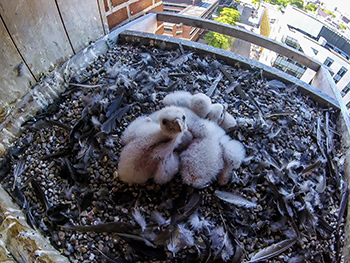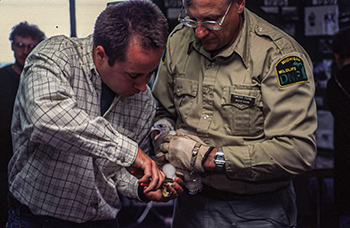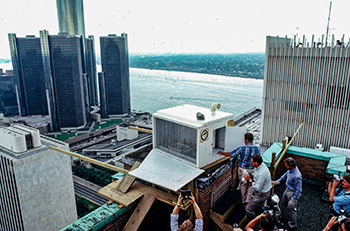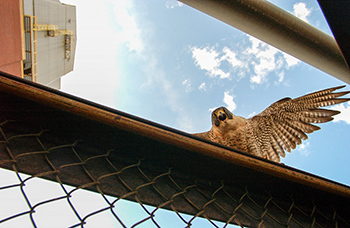Return of a wanderer
Editor’s note: In celebration of the department’s centennial anniversary, the Showcasing the DNR feature series will highlight one story each month during 2021 that recalls various accomplishments of the department over the past century. This is June’s story.
By KAREN CLEVELAND
Michigan Department of Natural Resources
Merriam-Webster defines the verb “peregrinate” as “to walk or travel over; traverse,” and peregrine falcons are truly travelers.
Peregrines can be found on every continent except Antarctica. They may travel thousands of miles on migration, and it’s not unusual for birds to settle down and start a nest hundreds of miles away from where they hatched as chicks.
While it’s now fairly common to read about falcons nesting on a bank in a downstate Michigan city or a cliff overlooking Lake Superior in the Upper Peninsula, it wasn’t always that way.
In Michigan’s early years of statehood, peregrines wouldn’t have been a common sight in our southern cities. The species nested only in northern Michigan, and then mostly on remote forested bluffs in the Upper Peninsula. Our best estimate of how many birds called the state home at that time is around 10-15 nesting pairs. Despite living in isolated and inaccessible places, peregrines weren’t safe. By the late 1950s, they’d disappeared from our landscape.

If you’re a Michigander, you likely know the story well – the buildup of toxins in the environment ranging from DDT to PCBs knocked out vital parts of the food web, sickened animals and kept them from being able to breed.
In the case of peregrine falcons, the concentration of DDT up the food chain, from insects to birds, meant the falcons’ diet contained high levels of the poison that would be their doom. As the DDT accumulated in their bodies, the shells of the eggs they laid got thinner over time until the weight of the parents was enough to crush them, foiling reproductive success.
It wasn’t until the 1970s, when these environmental contaminants were banned, that recovery of Michigan’s peregrines became a possibility. But by that time, all the peregrines in the eastern United States were gone.
Bringing them back would rely on an infusion of birds from a different source: captive breeding.
These efforts were groundbreaking.
|

A captive breeding program involves numerous facets, including researchers and falconers working together to better understand how to breed peregrines in captivity and ensure a healthy genetic mix in their offspring.
Federal scientists and regulators needed to provide legal protections, and state conservation partners would have to supply resources and expertise to find these birds new homes in the wild, along with the support they’d need to give them their best shot at survival.
The first step in the journey to Michigan’s peregrine falcon recovery was taken in Minnesota by Pat Redig and Harrison “Bud” Tordoff at the University of Minnesota. In the early 1980s, they acquired captive-bred peregrines and released them in Minnesota.
In 1986, Bob Hess with the Michigan Department of Natural Resources approached Redig and Tordoff about acquiring birds to release here in Michigan as well.
“Bob Hess contacted me one day to inquire about sourcing young falcons for release. I had an extensive network of breeders that were supplying our releases in Minnesota to the tune of about 30 falcons a year and in order to avoid a bidding war, I told Bob I would serve as an intermediary in acquiring young falcons that were matched age-wise and gender-wise for release,” Redig said, recalling how this led to the growth of the Minnesota program. “Based on this model, the program expanded to more than 100 falcons per year going to more than a dozen sites throughout the Midwest.”
|

Eventually, Redig and Tordoff would build a network of conservationists across 12 states and one Canadian province to share resources, expertise and research to support the recovery of peregrine falcons across the region.
It sounds simple: get birds and release them, but that fails to capture the complex process that was involved in turning hand-raised birds into wild ones.
It starts with something called a “hack box.” Since it was well known that birds often return to near where they hatched when it’s time for them to breed, one way to attract birds to nest in a location is to raise some chicks there and hope they return.
This is where the hack box comes in. It’s a large wooden box with a barred metal door covering the front and a small hinged door in the back. Chicks that are old enough to feed themselves, but not yet ready to fly, are kept in the box to get familiar with the sights and sounds of their new home while food is supplied through the small door in the back.
|

Once they’re ready to fly, the metal door on the front gets opened so the chicks can start testing their wings. Over time, they teach themselves how to hunt and live away from the support of the team that cared for them.
Each chick that learned these skills and flew away was an investment in the species’ future.
With all the daily care required to give these chicks their best chance at survival, the DNR looked beyond the places where peregrines historically nested in the state and set its sights on the man-made cliffs of Grand Rapids for the state’s first hack box.
McKay Tower, the tallest building between Detroit and Chicago until 1983, was chosen to host Michigan’s first peregrine release in the summer of 1986. With access to the roof to house the hack box, feeding and monitoring the chicks wouldn’t require packing supplies for a backwoods hike. The building where the hack box was placed was situated in the heart of downtown.
Lessons learned at this first site were invaluable as the hack box program expanded first to Detroit and then to more natural habitats on the bluffs of Isle Royale and Pictured Rocks National Lakeshore in the U.P. in the late 1980s and early 1990s.
|

By 1988, Michigan had its first pair of peregrine falcons defending a nesting territory in downtown Detroit. They didn’t raise any chicks that year, but their territorial behavior was an encouraging sign for the future.
It was a slow process waiting for falcons to discover Michigan as a possible home where they could nest. Some of those released chicks came back, but we also found birds from as far away as Toronto and Kentucky setting up housekeeping here.
Each year, DNR wildlife biologists would watch for new nest sites and work with the landowners there to help those pairs succeed.
“The local response has almost always been very positive,” said DNR wildlife biologist Nik Kalejs. “Elementary school classes have helped name the chicks and raise money for peregrine conservation. Local peregrine watchers have provided valuable information about nest box use, egg laying dates and hatching dates to help coordinate banding operations.
“Audubon club field trips were organized around falcon hatching and fledging activity. Newspapers and local television stations ran yearly stories about the peregrines and the newest batch of chicks, and the local building and utility companies took lots of pride in the peregrines and the company’s role in the restoration of the falcons. Sure, there were a few complaints about bird parts littering the ground around some downtown buildings, but the feedback was overwhelmingly positive.”
|

With their diet composed almost entirely of birds they catch in flight peregrines will sometimes drop an uneaten head or leg to the sidewalk below as they feed their chicks.
Over the years, the DNR built up networks of connections with peregrine landlords, birders and conservationists to keep a watchful eye on these nesting sites to protect them.
In 2020, the DNR and its partners actively monitored over 30 nesting pairs across the state.
Dina Maneval, of the Lansing Board of Water and Light, where the birds nest on the utility’s Eckert Power Station, had an experience typical of peregrine landlords.
“The peregrines chose the BWL, and we were here to help support their nesting efforts. When they identified Eckert as a good place to nest given the height of the building, BWL knew we could help them be successful,” Maneval said, “I found a blueprint of a peregrine nesting box online, asked our BWL construction shop to build it, and a nest was placed on the Eckert roof in 2007.
“In 2009, working with the students and staff at Moores Park Elementary School, who collected money for a program called Pennies for the Peregrine, BWL was able to purchase and install two Falcon Cams at the nest site, which still run 24/7 to this day. The connection has helped educate local classroom students, the Lansing community and those around the country on peregrines.”
While the bulk of these birds are ones taking advantage of man-made structures, the number of birds reclaiming homes on cliffs and bluffs in the U.P. has been slowly climbing, and we know of at least seven pairs of peregrines using these sites now.
The future of peregrine falcons in Michigan will likely be written by networks of urban landowners and U.P. conservationists.
Coal-fired power plants, like Consumers Energy B.C. Cobb Plant in Muskegon and the Presque Isle Power Plant in Marquette, once a core component in the falcon’s nesting landscape, are being decommissioned and demolished as they age, and cleaner power generation technology becomes available. The birds nested on the smokestack structures.
Falcon parents can be fearless in defense of their young and sometimes scare their urban neighbors. Peregrine landlords who embrace their role in the protection of the species and find ways to welcome them have been pivotal in the recovery of these falcons.
Peregrine falcons have become beloved residents of our city centers and reclaimed their place as a symbol of Michigan’s rugged north woods. With care and a little luck, they’ll hold that place for generations to come.
|
Check out previous Showcasing the DNR stories in our archive at Michigan.gov/DNRStories. To subscribe to upcoming Showcasing articles, sign up for free email delivery at Michigan.gov/DNR.
/Note to editors: Contact: John Pepin, Showcasing the DNR series editor, 906-226-1352. Accompanying photos and a text-only version of this story are available below for download. Caption information follows. Credit Michigan Department of Natural Resources, unless otherwise noted.
Text-only version - Showcasing - Peregrine falcon
Bridge: Michigan Department of Natural Resources wildlife biologist Kristie Sitar holds a newly banded peregrine falcon chick from the nest box on the International Bridge between Sault Ste. Marie, Michigan and Sault Ste. Marie, Ontario in 2020.
Chick: A bird bander attaches a band to a peregrine falcon chick, while Tim Payne of the Michigan Department of Natural Resources’ Wildlife Division looks on. The bands help researchers track peregrine falcon geographic movements.
Chicks: Peregrine falcon chicks in a nest box on the University of Michigan campus in Ann Arbor wait for their parents to bring their next meal.
Cobb: Peregrine falcon chicks at the B.C. Cobb power plant in Muskegon wait to be banded. The bands help researchers track peregrine falcon geographic movements.
Eckert 1, Eckert 2 and Eckert-4.jpg: A peregrine falcon photographed at the Otto E. Eckert Power Station in Lansing.
Eckert-3: Peregrine falcons photographed at the Otto E. Eckert Power Station in Lansing.
Hack: Peregrine falcon chicks are introduced to a rooftop hack box in Detroit as media documents the event./
|